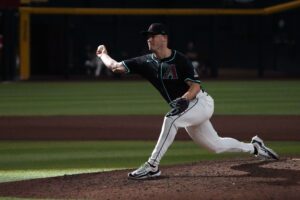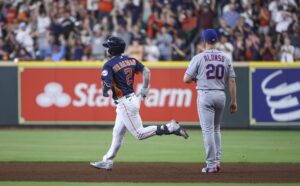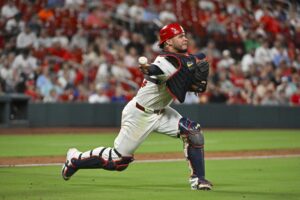It has happened. The National League is using the designated hitter, at least for 2020. Some National League fans will be seeing a style of play that they may not have seen much of outside of postseason play. There are also fans from all over the league who may not know the full background of it and some of the complexities of the rule. Here’s a look at how the designated hitter started, the rule itself – and its complications – and the strategy with its use.
The American League Adopts the Designated Hitter
American League teams had sagging attendance numbers in the 60s and early 70s. It had settled in a league-wide per-game average in the 12,000s. Five teams drew less than 10,000 per game. They theorized that declining offensive numbers were part of the reason, so they adopted the DH as a three-year experiment in 1973. Attendance increased by over 1,000 fans per game leaguewide. At the end of that three-year period, they kept it, and their attendance continued increasing, passing 19,000 fans per game by the end of the 70s.
Since the National League did not want it going into 1976, Major League Baseball allowed each league to decide on whether they wanted to use it. The National League did not even vote on it until the summer meetings in 1980. That vote was five against, four in favor, and three abstentions. They have not voted on it since.
Interleague Play
Younger fans may not know this, but regular season interleague play did not begin until 1997. Prior to that, the only time the leagues played against each other was the All-Star Game and the World Series. Between 1973 and 1975, they did not use the DH at all in the World Series. When the American League adopted it full-time in 1976, the leagues agreed to use the DH in the World Series in even-numbered years and not use it in odd-numbered years. That lasted until 1985. Beginning in 1986, the leagues agreed to use the rules of the home team. For games in American League parks, there was a DH; for games in National League parks, there was not. This is the format they used through 2019.
As far as All-Star Games go, they did not use it at all until they adopted the “home team’s rules” format in 1989. Starting in 2010, however, they have used the DH in every All-Star Game.
The Designated Hitter Rule
The rule itself – Rule 5.11 – has some complexities to it. Managers are not required to use it; they just have the option. However, it is extremely rare for them not to use it unless it’s done by mistake. In order to use the DH, the manager must list 10 players on his lineup card before the game and clearly indicate which one the DH is.
Once the game begins, the starting DH must bat at least once unless the opposing team changes pitchers. This is to prevent a tactic former Baltimore Orioles manager Earl Weaver used in the late 70s and early 80s: the “phantom DH.” He would sometimes name someone from his pitching rotation as the DH to mess with the opposing manager’s lineup decisions. There were times that the player he named wasn’t even in the stadium! Then, when the DH spot came up, he’d send up a pinch-hitter who had a favorable lefty-righty matchup with the pitcher.
Pinch-hitters and pinch-runners may be used for the DH. That player then becomes the new DH. However, the DH is a “locked” position. No double-switching can move the DH to another spot in the batting order. For example, if the DH is batting fifth and the shortstop is batting seventh, the manager cannot substitute two people and say that the new shortstop is batting fifth and the new DH is batting seventh. The new DH will still have to bat fifth.
The game pitcher may pinch-hit or pinch-run for the DH, but by doing so, he will make his team lose the DH for the rest of the game. Also, the only player that the game pitcher may pinch-hit or pinch-run for is the DH.
The Complicated Parts of the Designated Hitter Rule
If the DH takes a defensive position, his team loses the DH for the rest of the game. The pitcher takes over the batting order spot of the defensive player who left the game. For example, say that Christian Walker is the DH for an Arizona Diamondbacks game where Madison Bumgarner is pitching. Say also that Jake Lamb is playing first base. Walker is batting fifth and Lamb is batting seventh. If Walker takes the field as the first baseman, the D-Backs lose the DH and Bumgarner will replace Lamb in the seventh spot in the batting order.
Furthermore, if the pitcher switches to a defensive position, his team loses the DH, and the pitcher will bat in the DH’s spot in the batting order. This came up in the 2019 season during a game on July 24 between the Tampa Bay Rays and the Boston Red Sox. Adam Kolarek was pitching for the Rays. Manager Kevin Cash brought Chaz Roe into the game to pitch. However, Kolarek stayed in the game as the first baseman, replacing Ji-Man Choi. After Roe retired Mookie Betts on a fly to left, Kolarek returned to the mound. Nate Lowe then took over at first base.
The Short-lived Protest
Red Sox manager Alex Cora protested the game. The umpires, who had forgotten the rule, called New York for instruction. Since Kolarek took a defensive position, he took the spot of DH Austin Meadows – who was batting third – in the batting order. Choi – who was batting ninth – was, at least briefly, the pitcher, so when Roe entered the game, he took the number nine spot. When Kolarek returned to the mound, Roe went to first base, and he was the player Lowe replaced. Therefore, Lowe batted ninth. (Some claimed that since Cash didn’t specify where Roe would bat, that the umpires needed to make the decision for him. That, however, goes against both the rule about pitcher taking a defensive position and the DH being a “locked position.”) After the game, Cora rescinded his protest.
Designated Hitter Strategy
There are three major approaches to using the designated hitter over the course of a season. One is to have a full-time DH. We saw this in the early years of the DH with the California Angels (Frank Robinson), Oakland Athletics (Deron Johnson), and Orioles (Tommy Davis), among others. More recent examples include Harold Baines, Edgar Martinez, and David Ortiz. Another is to platoon players – have one player DH against righties and another DH against lefties. A third method – one that NL teams have tended to do in interleague games – is to rotate players in and out of the role, using it as a half-day off.
NL Strategies for 2020
What exactly will happen with the National League teams this season is not clear. Arizona Diamondbacks General manager Mike Hazen said Wednesday night that “I would imagine there (will be) some rotating through of our DH, given how our roster is currently constructed, whether it’s via matchup or otherwise. But, the season could dictate otherwise, and we end up with a full-time DH if somebody steps up and really handles that position.”
Manager Torey Lovullo added Thursday afternoon, “There’s going to be so many moving parts to what will be available to me, so (I don’t want to put) myself into a little bit of a corner by saying who it’s going to be exactly. All I know is we’ve got some really good players that weren’t going to possibly be playing every single day that now could be playing every day. I’m gonna try to be as strategic as possible and maximize our situation to score runs. (I will also be) mindful of when a guy needs to get off his feet.”
Most of the other National League teams will be in the same boat. National League rosters are constructed to have position players playing both ways. Some players are stronger defenders than others. The weaker defenders may be relegated to full-time DH duties, but few National League teams have players who are defensive liabilities.
Outlook
Teams who will benefit from the DH the most will be those who have more players who deserve to play every day than there are positions available. Take, for example, the Los Angeles Dodgers. They have four outfielders who realistically could play every day – Cody Bellinger, Joc Pederson, Betts, and A.J. Pollock. The Diamondbacks have three deserving corner infielders – Eduardo Escobar, Lamb, and Walker. Jesse Winker, Phil Ervin, Aristides Aquino, and Derek Dietrich all could see time as DH for the Cincinnati Reds. Winker, Ervin, and Aquino are corner outfielders, but Nick Castellanos and Nick Senzel seem to have a hold on those positions. Dietrich can play second or first, but he’ll be playing behind Mike Moustakas and Joey Votto, respectively. However, the Reds could use Castellanos full-time as the DH, since his defense is the weakest of everyone listed here.
These are only three examples. If the National League uses the DH in 2021 and beyond, they might reconstruct their rosters. But for now, they have to work with what they have. It will be interesting to see what they and the other 12 National League teams do in 2020.
Main Photo
Embed from Getty Images






